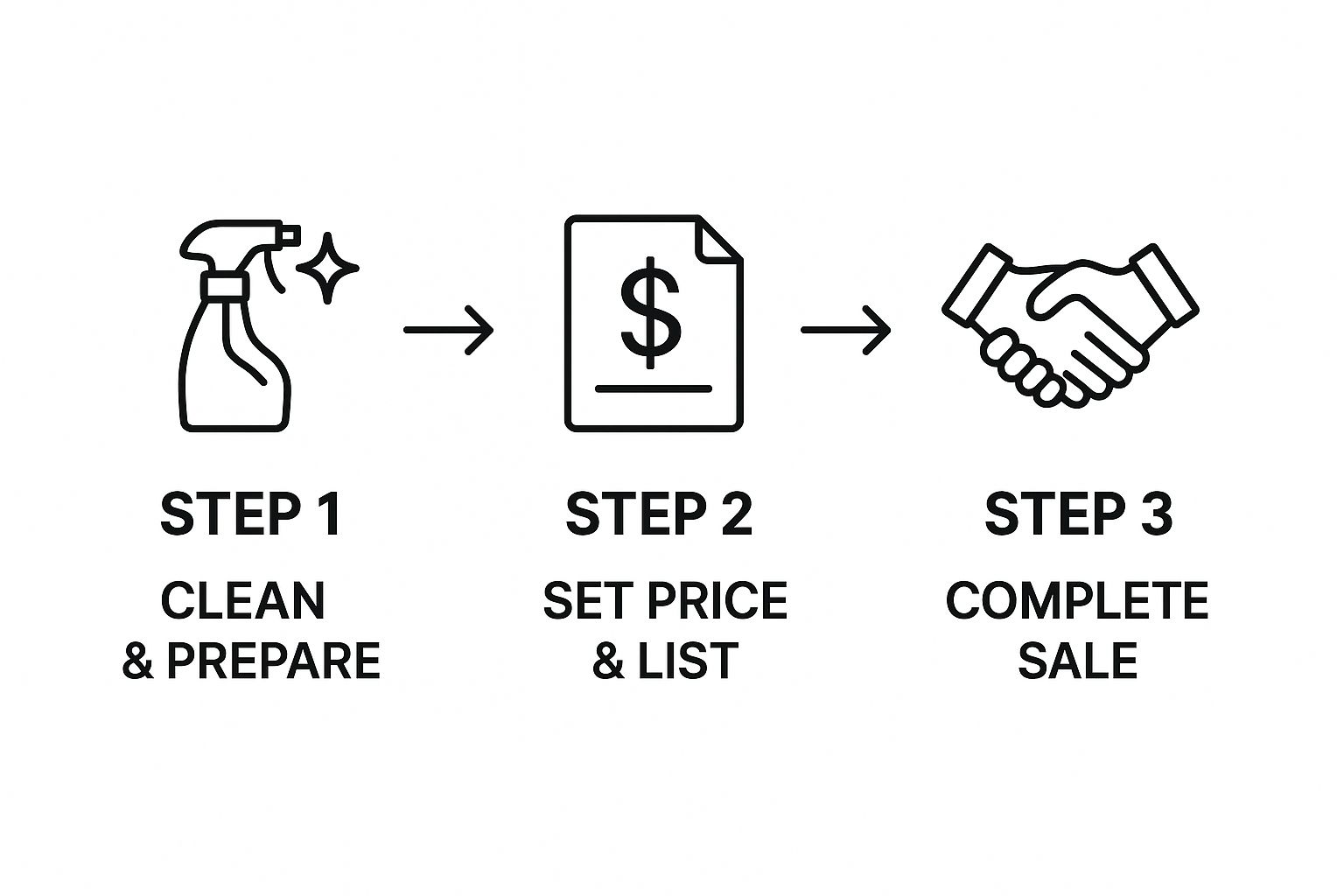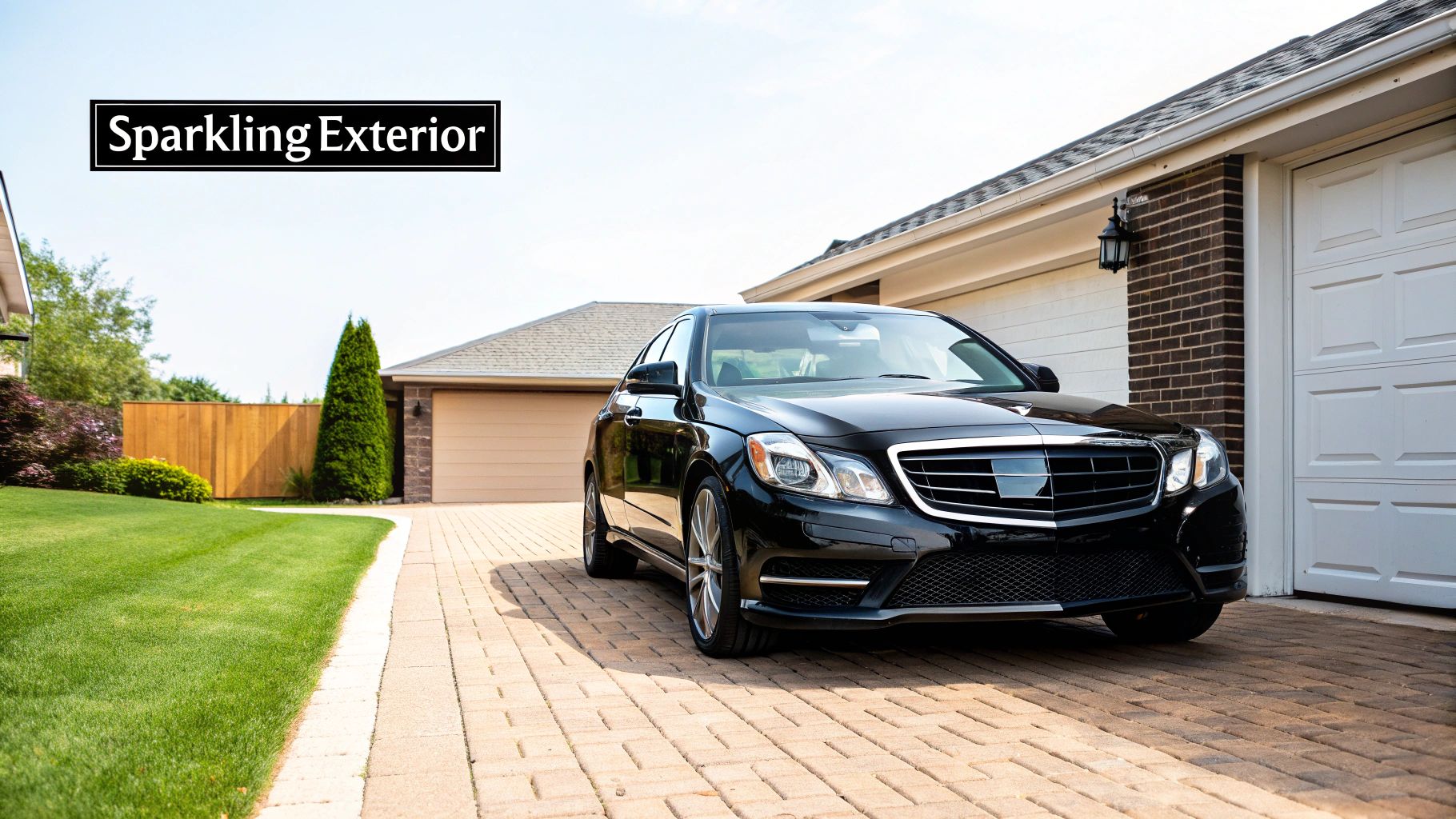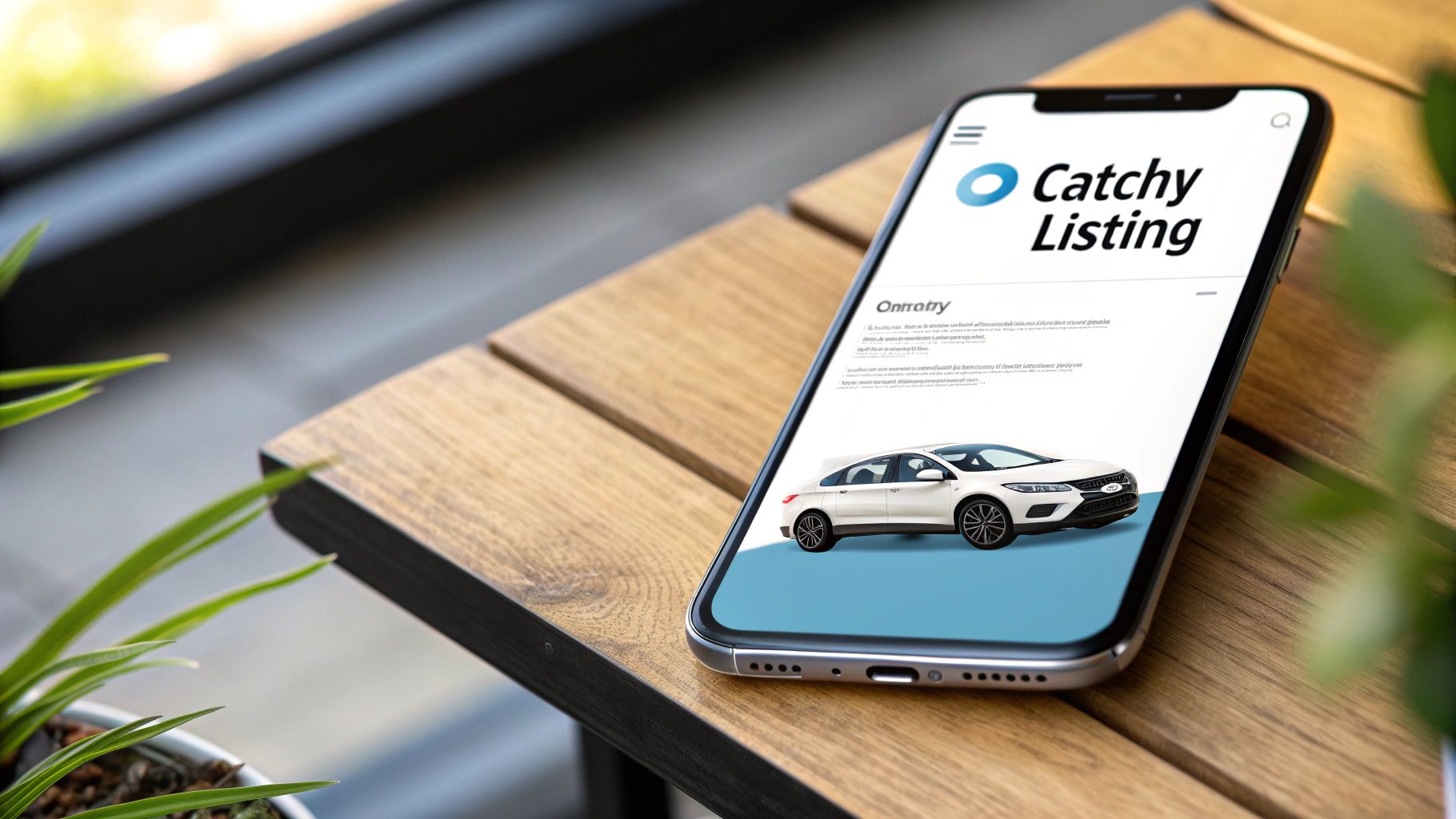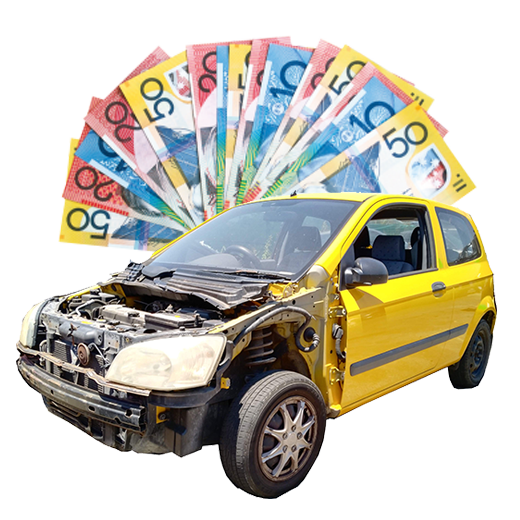Selling your car privately really comes down to three main phases: getting the car ready, creating a standout ad, and then safely closing the deal. If you get these stages right, you’ll not only get the best possible price but also sidestep the common traps that can trip people up. We're talking thousands more in your pocket compared to what a dealer would offer on a trade-in.
Your Roadmap to a Successful Private Car Sale
Thinking about how to sell a car privately can feel a bit overwhelming at first, but it’s really just a series of straightforward steps. It’s not a complicated process when you have a clear plan. The whole idea is to prep your car for its new owner while making sure you’re getting every dollar it’s worth. From a deep clean that instantly boosts its appeal to sorting out the final legal paperwork, each step logically follows the next.
Your aim is to move from prep to payment as smoothly and confidently as possible. Following a structured approach like this puts you in the driver's seat, allowing you to show off your car at its best and handle negotiations like you've done it a hundred times before.
Key Stages of a Private Sale
Here in Australia, the private car market is huge—around 15% of all vehicle sales happen this way. On average, you can expect the process to take anywhere from three to six weeks, so being organised from the get-go is key.
Success really boils down to a few core things: making the car look fantastic, setting a realistic price, and getting the legal transfer of ownership done correctly.
This handy visual breaks down the entire journey into three clear, actionable phases.

What this really shows is that a successful sale starts long before you even think about posting an ad and isn't truly over until the last form is signed.
To give you a clearer picture of what's involved, I've put together a quick overview of the entire process.
Private Car Sale Process at a Glance
This table breaks down the main stages you'll go through when selling your car privately in Australia. Think of it as your cheat sheet for a smooth, successful sale.
| Stage | Key Actions | Goal |
|---|---|---|
| Preparation | Deep cleaning, gathering documents, minor repairs. | Build trust and maximise the car's perceived value. |
| Listing & Marketing | Researching price, taking quality photos, writing a great ad. | Attract serious, high-quality buyers quickly. |
| Sale & Transfer | Managing test drives, negotiating, completing paperwork. | Ensure a safe, secure, and legally sound transaction. |
By following this roadmap, you'll be in a great position to manage the entire process with confidence and get the best result for your sale.
Getting Your Car Ready to Impress Buyers

The moment a buyer lays eyes on your car, they're forming an opinion. That first impression is everything. When you're selling privately, a bit of elbow grease and a small investment in presentation can seriously boost your final sale price—often by hundreds, if not thousands, of dollars.
This isn't just about a quick run through the car wash. It's about showing off a vehicle that looks like it's been genuinely cared for. This simple act builds immediate trust, justifies your asking price, and gives you a much stronger footing when it comes time to negotiate.
A Deep Clean Makes All the Difference
Never underestimate the power of a proper, thorough clean. Honestly, it's the best return on investment you'll make in this whole process. Forget the quick drive-through wash; you need to get into the details that buyers really notice.
A full interior and exterior clean is your starting point. To make your car truly stand out from the rest, consider doing some basic car detailing yourself. Pay close attention to the spots where grime loves to hide, like the wheel arches, door jambs, and even the engine bay. A sparkling clean engine bay, in particular, screams "well-maintained" and gives buyers a huge confidence boost.
Inside, your mission is to make the car feel as close to new as you can.
- Empty Everything Out: Clear all your personal stuff from the boot, glovebox, and every single storage pocket. No one wants to see your old receipts or gym gear.
- Vacuum Like You Mean It: Get into every nook and cranny. Pull the seats forward and back, get under the floor mats, and don't miss the boot.
- Get Rid of Odours: Lingering smells from pets, food, or smoke are massive turn-offs. Don’t just mask them with an air freshener; use a proper odour eliminator to get rid of them for good.
A clean, fresh-smelling interior has a huge psychological impact. It helps a potential buyer imagine the car as their own, which is a critical step towards them making an offer.
Organise Your Paperwork Like a Pro
One of the most convincing things you can show a buyer is a neat folder full of organised records. It’s tangible proof that you've looked after the car and a clear sign that you've been a responsible owner.
Get all your documents together: the original logbook, every service receipt you can find, and any invoices for significant work like new tyres or a timing belt replacement. Pop them into a simple presentation folder, arranged by date. This professional touch tells buyers you're a serious, transparent seller, making them feel more secure and less likely to try and lowball you.
Small Fixes That Pay for Themselves
You don't need to sink a ton of money into major repairs, but tackling the small cosmetic flaws can have a massive payoff. Every little imperfection is a potential bargaining chip for a savvy buyer. Your goal is to take those chips off the table.
Focus on cheap and easy fixes that make a big visual difference.
- Grab a touch-up paint pen to sort out those annoying stone chips on the bonnet.
- Replace any plastic trim pieces that are obviously cracked or faded.
- If the floor mats are looking tired and worn, a new set is a cheap and effective upgrade.
- Use a simple polishing kit to clear up cloudy or yellowed headlights.
Each of these little jobs adds up. They all contribute to that crucial overall impression of a well-loved vehicle, helping you lock in the best possible price.
How to Price Your Car for a Competitive Sale

Getting the price right is make-or-break. Ask too much, and your phone will stay silent. Go too low, and you're leaving cash on the table. The trick is to find that perfect middle ground, and you do that by looking at what the market is actually doing right now.
Forget what you think your car is worth or how much you love it. Your goal is to become an expert on what buyers are willing to pay for a car just like yours, in its current condition. This data-first approach takes the guesswork out of it and sets you up for a much smoother sale.
Research Real-World Market Value
The best place to start your detective work is on Australia’s biggest online car marketplaces. Jump onto sites like Carsales and Drive, because they are goldmines of real-time data. Your mission is to find cars that are as close a match to yours as possible.
You'll want to get forensic with your search filters:
- Exact Make, Model, and Year: This is your starting point for building a pool of comparable vehicles.
- Kilometres Travelled: Try to find listings within a 10,000-15,000 km range of your car's odometer reading.
- Trim Level and Engine: A base model Mazda 3 is a very different beast to the top-spec SP25 Astina, so be specific.
- Condition: This is where honesty is key. Compare your car to others with similar scratches, dings, or interior wear.
Once you’ve found a handful of genuinely similar cars, you’ll quickly see a price bracket form. This isn't a guess; it's a realistic snapshot of what buyers are looking at right now. Keep in mind that in the Aussie market, popular models like utes and SUVs tend to hold their value incredibly well. If you're selling one of these, you might be pleasantly surprised at its resale strength.
Expert Tip: A complete logbook showing consistent servicing from a trusted mechanic is one of your most powerful selling tools. It screams "this car has been looked after" and can easily add $500 to $1,500 to your asking price compared to an identical car without one.
Factor in Your Car’s Unique Selling Points
With a base price range established, it's time to fine-tune it based on what makes your car special. Even identical models can have very different values.
Think about what makes your car stand out from the pack.
- Desirable Factory Options: A factory sunroof, an upgraded leather interior, or a premium sound system are all things you can leverage for a higher price.
- Recent Major Maintenance: Just dropped $1,200 on a new set of quality tyres or had the timing belt replaced? That’s a huge plus for a buyer, so make sure your price reflects it.
- Pristine Condition: If your car is genuinely immaculate for its age and kilometres, don't be afraid to price it at the very top of the market range.
On the flip side, you have to be realistic about any drawbacks. A large dent in the door or a warning light on the dash means you'll need to price your car more aggressively at the lower end of the value bracket to attract buyers. If the car has significant mechanical problems, a private sale might not be your best bet, and exploring the best cash for cars services could be a far more practical solution.
The Art of Pricing for Negotiation
Here’s a little secret to private sales: buyers love to feel like they’ve won. A smart seller always builds a little bit of wiggle room into the asking price.
A good rule of thumb is to list your car for about 5-10% more than the absolute lowest price you’d be happy with.
Let’s say you need to get $15,000. Listing it for $16,500 gives a potential buyer the chance to offer $15,500, you can counter, and you both meet in the middle. They walk away feeling like they got a great deal, and you walk away with the price you wanted. Everyone wins.
Creating an Online Listing That Gets Noticed

Think of your online ad as your 24/7 salesperson. It's out there working for you, grabbing the attention of potential buyers even while you're asleep. A thoughtfully put-together listing can spark immediate interest, while a lazy one will just get scrolled past.
Today's private car market is almost entirely online. This gives you fantastic reach, but it also means you're competing in a very crowded space. The quality of your ad is what makes all the difference. To really make your car stand out, you can even borrow a few digital marketing tips for a standout listing.
Taking Photos That Sell the Car for You
Before you type a single word, you need great photos. It’s simple: buyers are visual, and high-quality images are the number one reason they'll click on your ad over someone else's. Don't worry, you don’t need a fancy camera. Your smartphone is more than capable if you just follow a few ground rules.
Timing is everything. Try to shoot during the "golden hour"—that sweet spot in the first hour after sunrise or the last hour before sunset. The soft, angled light makes the car's colour look incredible and cuts down on those harsh reflections and dark shadows that hide details.
A great set of photos tells a complete story. To make sure you've got all the essential shots covered, I've put together a handy checklist.
Essential Photos for Your Car Listing
This table is a checklist of must-have photos to create a comprehensive and trustworthy online car advertisement.
| Photo Angle/Subject | Why It's Important | Pro Tip |
|---|---|---|
| Front Three-Quarter View | This is the classic "hero shot" that grabs attention and shows off the car's best lines. | Turn the steering wheel slightly so the front tyre is angled towards the camera. |
| Rear Three-Quarter View | Complements the front view and gives a full sense of the car's shape and condition. | Ensure the background is clean and uncluttered so the focus stays on the car. |
| Direct Side Profile | Shows the car's length and overall proportions. It's crucial for revealing panel straightness. | Shoot from a low angle to make the car look more imposing and dynamic. |
| Front & Rear Straight-On | Clearly shows the condition of the grille, headlights, bumper, and taillights. | Make sure the car is perfectly centred in the frame for a professional look. |
| Dashboard & Cockpit | Gives a feel for the driver's environment and shows the condition of the steering wheel and controls. | Turn the ignition on (without starting the engine) to light up the dash, but ensure there are no warning lights showing! |
| Front & Rear Seats | Shows the upholstery condition, cleanliness, and available space. | Use a vacuum and a damp cloth to make sure the interior is spotless before you shoot. |
| Odometer Reading | A non-negotiable shot. It provides proof of the kilometres you've listed. | Get a clear, in-focus close-up. No blurry photos here. |
| Boot Space | Buyers want to see the size and condition of the boot. | Remove all personal items. A clean, empty boot looks much larger. |
| Wheels & Tyres | A close-up shows the condition of the alloys and the amount of tread left on the tyres. | Clean the wheels and apply tyre shine for a new-car look. |
| Engine Bay | A clean engine bay suggests a well-maintained car. | Give it a wipe down. You don't need to steam clean it, just remove leaves and dust. |
| Logbook & Service History | This is your proof of maintenance and a massive trust-builder. | Fan out the pages to show the service stamps. Cover your personal details. |
Taking the time to capture all these angles pays off. It shows you’re a thorough and honest seller, and it answers a buyer’s initial questions before they even have to ask.
A comprehensive set of 20-30 high-resolution photos builds instant trust. It shows you have nothing to hide and saves both you and the buyer time by answering many initial questions before they even contact you.
Writing a Description That Builds Confidence
Now it’s time to match those brilliant photos with a description that seals the deal. The goal is to be both honest and persuasive.
Kick things off with a strong title that includes the essentials plus a standout feature. Something like, "2018 Toyota Corolla Ascent Sport – Full Service History" is perfect.
Structure the description so it's easy to read. I always start with the key stats: kilometres, registration expiry, and transmission type. Then, I move into a short paragraph or two that tells the car's story, highlights its best features, and gives a genuine reason for selling.
Honesty is your best policy here. Instead of just saying "good condition," try something more descriptive like, "Excellent condition for its age with only minor cosmetic marks consistent with daily use." If you've recently done a major service, like replacing the timing belt or fitting four new premium tyres, shout about it! These are huge selling points that justify your price.
Perfecting Your Listing Before You Publish
Before you hit that 'publish' button, take five minutes to read over everything. This is your last chance to catch typos and make sure you've presented your car in the best possible light. A polished, error-free ad signals to buyers that you're a careful and trustworthy person to deal with. It really does make a difference.
Fielding Enquiries and Nailing the Test Drive
Once your ad is live, your phone will start buzzing. It’s a great feeling, but this is where you need to switch from advertiser to savvy seller. Your first mission is to sort the genuine buyers from the tyre-kickers and, unfortunately, the odd scammer.
You'll quickly learn to spot the difference. Low-effort messages like "Is this still available?" are often a red flag. A serious buyer has usually done their homework and will ask something specific, like "Has the timing belt been replaced?" or "How are the tyres?"
Have a few of your own questions ready to go. Simple things like, "What are you looking for in your next car?" or "Have you driven one of these before?" can tell you a lot. You’re not interrogating them; you’re just getting a feel for how serious they are before you clear your schedule.
How to Set Up a Safe Inspection
When you've found someone who sounds promising, it's time to arrange a meet-up. Let me be clear: your safety is non-negotiable. Don't ever give out your home address or have a stranger come to your house.
Always, always pick a neutral, public spot.
- The car park of a busy local shopping centre during the day is perfect.
- The visitor parking area at a police station is another brilliant choice—it tends to put off anyone with dodgy intentions.
- A well-lit service station also works well, with plenty of cameras and people around.
This simple rule protects your privacy and keeps the whole transaction in a safe, open space.
Before you head out, shoot a quick text to a friend or family member. Let them know where you’re going, who you’re meeting, and when you’ll be back. It’s a simple habit that adds a huge layer of security.
Before you hand over the keys for a test drive, you need to see their driver's licence. A physical licence, not a photo on their phone. Snap a quick picture of the front and back with your own phone. This confirms who they are and gives you a record, just in case.
Running a Great Test Drive
The test drive is where the car gets to shine, with you playing the role of the expert guide. The number one rule? You go with them. No exceptions. Letting a stranger take your car for a spin alone is just asking for trouble.
Plan a simple route beforehand that takes around 15-20 minutes. A good mix of local roads and a quick run on a highway is ideal. This lets them get a feel for the car in different conditions—how it handles around town and how it performs at speed.
While they’re driving, you can chat and point out some of the car's best qualities. Don't be a pushy salesperson. Just be natural. You might mention how responsive the steering is or how quiet the ride is on the open road. You’re simply reinforcing the value you've already advertised, building trust, and setting the stage for a friendly negotiation.
Getting the Paperwork and Payment Sorted
You've navigated the inspections, aced the test drive, and shaken hands on a price. Excellent. Now for the most critical part of the whole process: getting paid and officially handing over ownership. This is the final hurdle, and getting it right is non-negotiable for a clean, stress-free sale.
This stage is all about creating a clear, legal separation between you and your old car. It protects you from any future fines or issues that might crop up. It might seem like a bit of a hassle, but taking your time and doing it by the book will save you massive headaches down the road.
What's the Deal with the Roadworthy Certificate?
One of the first things you'll need to think about is the Roadworthy Certificate (RWC), sometimes called a Safety Certificate. The rules around this change dramatically depending on which state you're in. For example, if you're selling a car in Queensland or Victoria, you absolutely must provide a current RWC for most sales.
Trying to skip this step where it's mandatory can void the whole deal and get you into some serious trouble. On the other hand, in states like New South Wales, you generally don't need one unless the car's registration has lapsed. Before you go any further, jump on your state's transport authority website and confirm the exact requirements for your situation.
For a complete rundown, our guide on whether you can sell a car without a roadworthy breaks down the specific rules for every state in Australia.
Securing Your Payment—The Safe Way
This is the golden rule of selling anything privately: never, ever hand over the keys or sign a single document until the full payment is cleared and sitting in your bank account. Scammers are masters of creating a sense of urgency, often using fake payment screenshots or dodgy excuses to rush you into a bad decision. Don't fall for it.
Stick to these safe payment methods:
- Direct Bank Transfer (EFT): This is your best bet. It's secure, fast, and easy to verify. The key is to check your own banking app to see the funds. Don't just accept a screenshot of their "payment confirmation" as proof—wait until you see the money in your account with your own eyes.
- Bank Cheque: This is another solid, secure option. Unlike a personal cheque, the funds for a bank cheque are guaranteed by the bank that issues it. For total peace of mind, you can arrange to meet the buyer at their bank branch, watch them get the cheque drawn up, and then head straight to your bank to deposit it.
Stay away from personal cheques entirely—they can easily bounce days after you’ve handed over the car. Also, be very cautious if a buyer insists on paying with a large sum of cash. It brings a whole host of risks, from counterfeit notes to personal safety concerns.
Making the Transfer Official
Once the money is safely in your account, it's time to do the final paperwork. You and the buyer will need to fill out and sign the official vehicle transfer form for your state. You can nearly always download a copy directly from your local transport authority's website.
After you've filled in your part, give the buyer their section of the form along with the signed registration papers and the RWC (if you needed one). From here, it's their job to lodge the transfer and pay the stamp duty and fees.
Your final, crucial step is to submit a Notice of Disposal. This little form officially tells the transport authority that you no longer own the vehicle. It's your ultimate protection against any future speeding fines, parking tickets, or registration issues. Whatever you do, don't forget this last step.
Your Top Questions Answered: A Seller's FAQ
Even with the best game plan, a few tricky questions always seem to pop up right at the end of a private car sale. Getting these sorted quickly is the key to a smooth, stress-free handover.
Here are the answers to the questions we hear most often from sellers across Australia.
Do I Actually Need a Roadworthy Certificate to Sell?
This is a big one, and the answer is a classic "it depends" – specifically, on where you live.
In states like Victoria and Queensland, you absolutely need a current Roadworthy Certificate (RWC), or Safety Certificate as it's known up north, for most private sales. But if you're in New South Wales, it's a different story; you generally don't need one unless the rego has lapsed. The rules change, so your first stop should always be your local state transport authority’s website to get the latest, most accurate info.
What’s the Safest Way to Get Paid?
When it comes to the money, you can't be too careful. The most secure ways to accept payment are a direct bank transfer (often called an EFT) or a good old-fashioned bank cheque.
With a bank transfer, the golden rule is to see the money cleared and available in your account with your own eyes. Don't ever accept a screenshot of a payment receipt as proof – they're too easy to fake. A bank cheque is also a very safe bet, as the bank itself guarantees the funds. I'd strongly advise against personal cheques, and think very carefully before accepting thousands of dollars in cash.
Watch out for this classic scam: A buyer "accidentally" overpays with a dodgy cheque and then asks you for a refund of the difference. Days later, their cheque bounces, and you're out of pocket for both the car and the "refunded" cash.
Should I Let a Buyer Test Drive the Car Alone?
The short answer is: never. Not under any circumstances. Always go with them, sitting in the passenger seat.
Before you even hand over the keys for a test drive, run through this quick checklist:
- Ask to see their physical driver's licence (not a photo on their phone).
- Snap a quick, clear photo of the front and back of it with your own phone.
- Double-check that your car insurance policy covers other licensed drivers.
It might feel a bit formal, but this simple process protects you if there’s an accident and is your best defence against potential theft. It's a non-negotiable step for a safe sale.
Have an old, scrap, or unwanted car that's seen better days? Auto Removal Adelaide can turn it into cash, fast. We pay up to $8,999 on the spot and offer free car removal right across Adelaide. Get your free quote by visiting us at https://autoremovaladelaide.com.au today.


